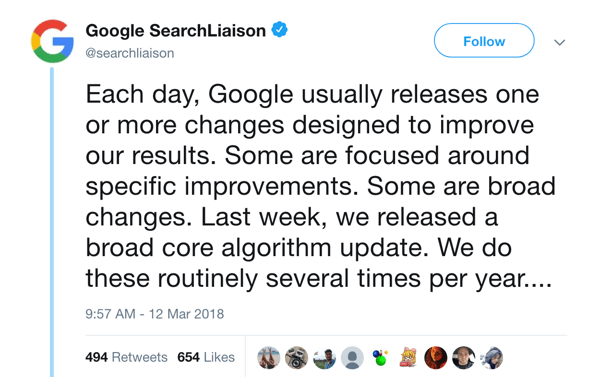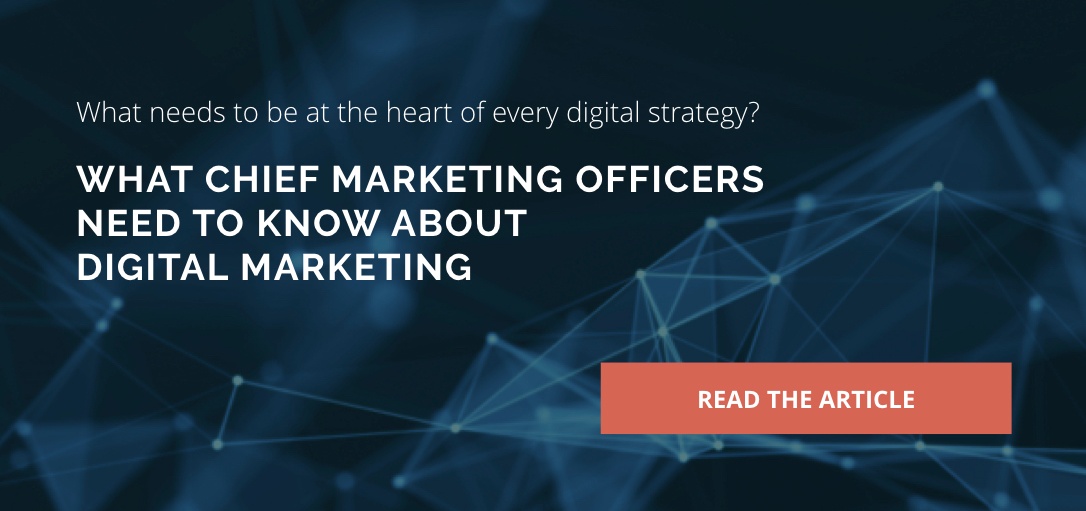Google has once again updated its core algorithm on 12 March with noticeable changes in its search indexes all over the world. Here’s a look at what we can expect from the March 2019 algorithm update and what Google is also up to in the future of search.
Insight: Google is laser-focused on transparency, attention, and AI in delivering search results to its users.
Data: 3.5 billion Google searches are made every day, and the volume of Google searches grows by roughly 10% every year. (Internet Live Stats)
Key Action Point: Actively incorporate search marketing in your arsenal and keep abreast with the latest search algorithm updates and digital evolutions to stay ahead of everyone else in your industry.
Google’s March 2019 Core Algorithm Update
Google has recently announced the release of a broad core search algorithm on March 12 through its Google SearchLiaison account.

On Website Rankings and Fixes
Keyword boosts have also been noticed, with some keywords that ranked at hundreds reaching the first to the second page of Google’s SERPs. These websites were from different industries, which looked to confirm that the algorithm update does not target specific industries and is rewarding websites with great content that meet Google’s standards.
Although some websites may have noticed significant drops or gains, Google confirmed that this update is not specifically targeted at anyone. And sites that may have been previously under-rewarded may experience more gains.
Google also said that there is no fix for sites that are not ranking well before or after the update other than focusing on improving their content and building page authority.
Although it is too early to confirm the impact of this update, as with specific changes released in the past, the algorithm change is bound to affect the website rankings and general traffic.
An Increased Priority in User Signals and Search Intent
According to an analysis by searchmetrics, there was a drop in traffic to niche pages. Google seems to now be prioritising sites that generate more time on the website, get higher page views per visit, and have lower bounce rates.
This means websites need to focus on creating high-quality content on key subjects rather than focus on single or niche keywords. This is important so that website visitors are more inclined to click through more content and spend longer on-site.
Improving the user experience and making sure website journeys are a seamless experience can be another way to encourage them to spend more time on your website and look through more of your content.
In optimising for intent, consider what users want to really know about and the reason behind their search query.
Google and Its Stand on Transparency
In a recent interview with Pandu Nayak, Vice President of Search at Google, we learned about Google’s push for transparency and how Google is building trust with its users and businesses.
“What’s remarkable about search is that it works. It gives you what you’re looking for. As new users come online, we want to build new experiences that show them what they can do with search to get that access to information easily. The underpinning that makes search continue to be successful is that it does what you want it to do. “
When asked about transparency and how Google is working to provide more transparency and build trust with users and businesses, he answers:
“Transparency is really important for Google. It’s the foundation of trust. In our evaluation processes, we publish guidelines on what makes great search. Our Ranking algorithm is just an approximation of this North Star that makes great search. These guidelines have been public for many years now. So anyone can look at it and check what Google is trying to do and there’s the answer. That’s a key part of transparency. “
He also adds that on the search page, Google is now more transparent about what is paid for and what is not. Ads are being clearly marked as paid for, which adds a lot of transparency and increases trust in their research.
He further notes,
“We continue to look at increasing transparency in various ways that makes sense with the caveat that too much transparency runs severe risks of spammers or people with malicious intent trying to get the algorithm to try to rank highly rather than building great content for their users. So we’re always trying to play this balance appropriately.”
AI and the Future of Search
Pandu Nayak points out that artificial intelligence is central to the future of search because these AI and machine learning algorithms are beginning to provide capabilities that have not been made possible before.
This, to him, has led to quantum improvements in things that Google has been trying to do before.
One of the things that have improved dramatically over the years because of machine learning is speech recognition. With so many parts of the world struggling with literacy, AI has opened the means to access information that has not been made possible before.
Language understanding, which is key to what is being done in Google, is also another area that is seeing a lot of transformation. Pandu Nayak says that these improvements have helped them better understand the language of queries, the language of documents.
Vision is also another area where a lot of advancements have been made. Nayak adds that today we can now look at not just the words around images but analyse their content to see if it is appropriate for you or not. We’re seeing this transformation happening in a variety of different areas, all powered by artificial intelligence.
Final Thoughts
Whether or not you were affected by Google’s latest algorithm update, there’s no doubt that businesses need to strive towards maintaining transparency and trust to keep their brand in front of prospects and customers.
Australian businesses should also be considering how to take advantage of Google’s continually evolving machine learning capabilities to remain relevant in a digital world that relies more on speech and vision and less on your digits.









![#KatieTalks to Step Change’s Robert Steers [PODCAST]](https://blog.hellostepchange.com/hubfs/BLOG/Posts/5-Connection/katie-talks-robert-steers.001.jpeg)






